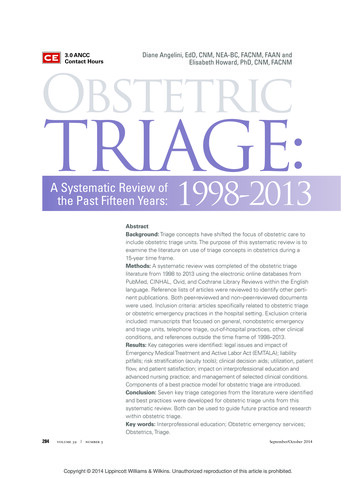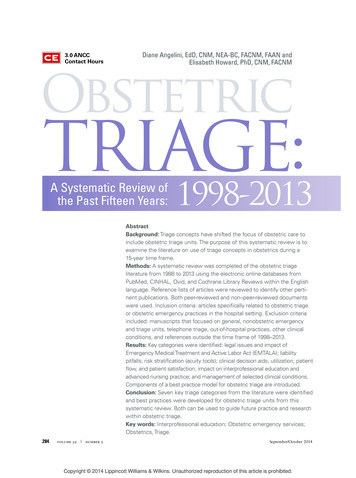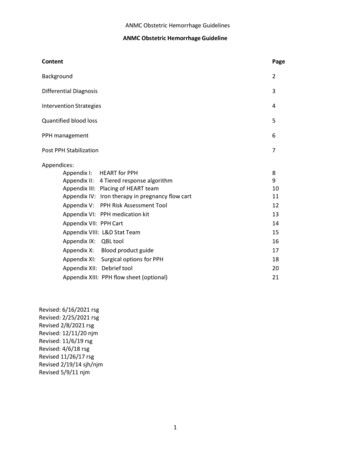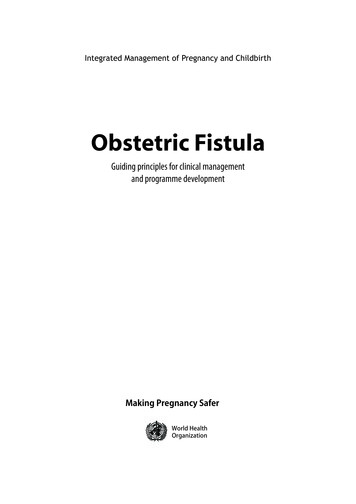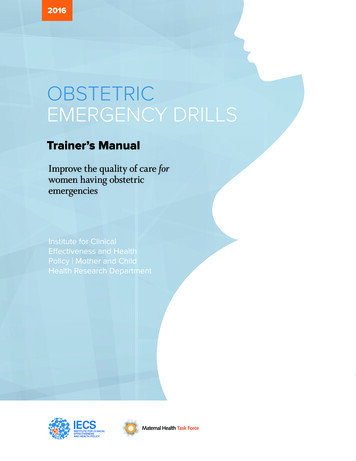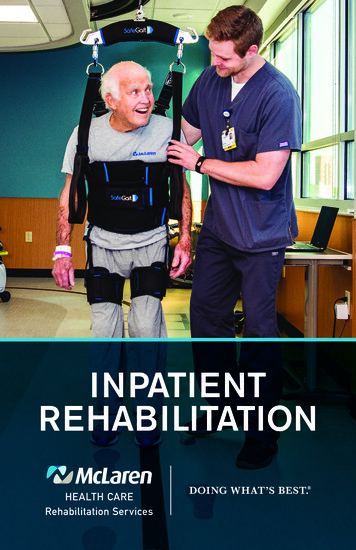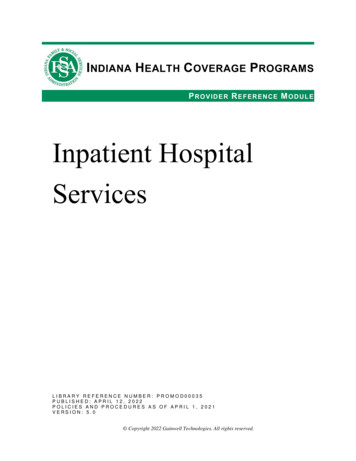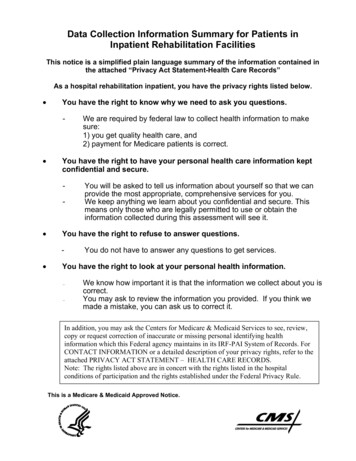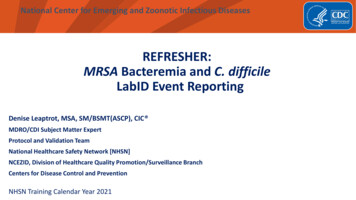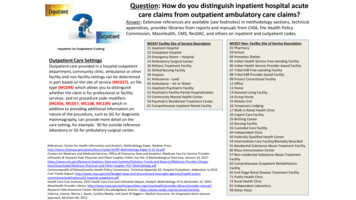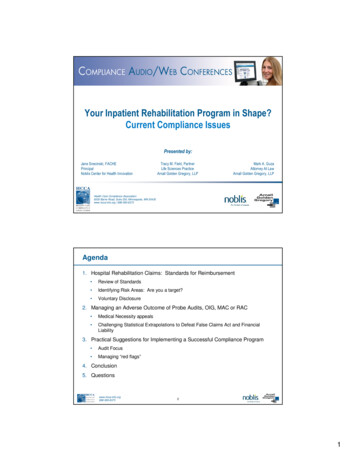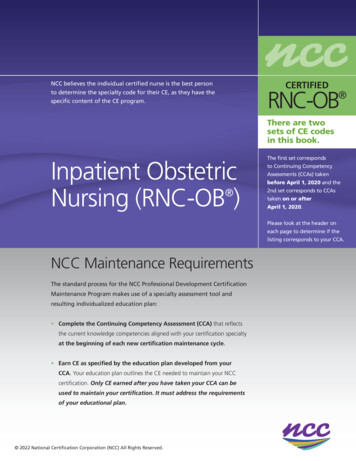
Transcription
NCC believes the individual certified nurse is the best personto determine the specialty code for their CE, as they have thespecific content of the CE program.CERTIFIEDRNC-OB There are twosets of CE codesin this book.Inpatient Obstetric Nursing (RNC-OB )The first set correspondsto Continuing CompetencyAssessments (CCAs) takenbefore April 1, 2020 and the2nd set corresponds to CCAstaken on or afterApril 1, 2020.Please look at the header oneach page to determine if thelisting corresponds to your CCA.NCC Maintenance RequirementsThe standard process for the NCC Professional Development CertificationMaintenance Program makes use of a specialty assessment tool andresulting individualized education plan: Complete the Continuing Competency Assessment (CCA) that reflectsthe current knowledge competencies aligned with your certification specialtyat the beginning of each new certification maintenance cycle. Earn CE as specified by the education plan developed from yourCCA. Your education plan outlines the CE needed to maintain your NCCcertification. Only CE earned after you have taken your CCA can beused to maintain your certification. It must address the requirementsof your educational plan. 2022 National Certification Corporation (NCC) All Rights Reserved.
CONTINUING COMPETENCY ASSESSMENTCERTIFIEDRNC-OB The CE requirements for your NCC maintenance will be outlined in your education plan!Your educational plan is derived from your Continuing Competency Assessment (CCA) and outlines for youthe CE needed in each of your core competency areas. Each core area has a code and that code is providedfor you as well. Take the CCA as soon as you can in the beginning of your maintenance cycle.The CCA may be taken early, up to 3 months prior to the start of your new maintenance cycle date.The start day for earning CE remains at the first day of the new maintenance cycle. YOU CAN ONLY USE CE EARNED AFTER YOU HAVE TAKEN YOUR CCA FOR MAINTENANCE.ANY CE EARNED BEFORE YOU TOOK THE CCA CANNOT BE USED (EVEN IF IT MEETS YOUR EDUCATION PLAN).YOUR CE AND NCC MAINTENANCE REQUIREMENTSAll CE must be earned during your current maintenance cycle and after you have taken the CCA.All CE used for NCC maintenance is defined by the individuals Education Plan.All CE must be submitted online at NCCwebsite.org.All CE must be coded to the applicable core content area. See listing in this brochure.CE can be entered into the maintenance application any time after the assessment has been taken and on anongoing basis. All activities will be saved until the application is submitted.All CE must be accredited by an agency recognized by NCC.ACCREDITING AGENCIESAcademic credit is accepted as is CME credit. For continuing education credit to be accepted for the purposeof maintenance, the continuing education activity must be accredited by one of the agencies below. NCC State boards of nursing andState nursing associations Nursing, medical or health care organizations(this would include, for example, suchorganizations as: ANCC, ANN, AWHONN,NPWH, NANN, NANNP, ACOG, AMA, AAP, etc.) Colleges or universities For-profit or not-for-profit continuing educationorganizations provided that programssponsored by such organizations have beenaccredited for continuing education.Most of the for-profit organizations have achieved accreditation for their offering through a state board ofnursing or health care organization. Review accreditation details in the registration brochure you receivedwhen registering for the particular continuing education activity.THE NATIONAL CERTIFICATION CORPORATION2
COMMON CODING QUESTIONSI went to aconference withtopics that reflectmany differentcodes, how do Icode them?CERTIFIEDRNC-OB You have two options:You can code to the content area that represents the majority of the contentpresented.ORYou can breakout content per code (You may combine different sessions of thesame content code.) and record total hours for each code, listing the sameconference for every content code entry.I could not list allOnce you meet or the CE requirements designated by your education planmy CE. I have many the application will automatically take you to the payment page. There is nomore hours but the need to enter more CE than is required.maintenanceapplication wouldnot let me list them.I was a preceptorfor new students,can I use this formaintenance andhow do I list it onthe application.How do I code it?10 hours of CE can be used for precepting students, in your same certificationspecialty area and role. (e.g. In order for a WHNP to use the credit they cannotpreceptor nurse midwives or residents – only WHNP students.) Orienting newstaff is NOT considered as preceptor hours. On the application select themore information link for the preceptorship code 24 and it will give youinformation on how to list the information. This is also applicable to anyof the “other” codes. You can only use these hours for baseline hours and nothours designated in the education plan assigned to a specific competency area.Baseline hours are listed as hours that are assigned to any competency area andappear at the bottom of your plan.I have multiplecertifications.Can I use the sameCE for both. Howcan I code it fortwo differentcertifications.If the CE is applicable to both areas and was earned in the appropriatetime frame for each certification, yes. But you still need to file a separatemaintenance application and fee for each certification. Each CE activity willbe coded to each application.Do I have to submita “MaintenancePre-approval”?Maintenance Pre-Approval is optional and not required. If you are unsureyour continuing education activities will meet your NCC maintenancerequirements, you can ask NCC to pre-approve your CE activities. There is anonrefundable fee for this service. Complete details are in the maintenancesection of NCCwebsite.org.THE NATIONAL CERTIFICATION CORPORATION3
HOW TO READ THE EDUCATION PLANCERTIFIEDRNC-OB Competency areas where 7.5 specialty index is achieved, no CE is needed. Competency areas where 7.5 specialty index is not achieved, the hours of CE needed will be listed. Every plan has a minimum of 15 CE hours - these are called baseline hours. Even if a specialtyindex above 7.5 is achieved in every competency, there is still a CE commitment of 15 hours.Education plans that need 45 hours, do not have any baseline hours because those hours areassigned to the specific core competencies. Every plan is composed of a maximum of 50 and a minimum of 15 CE hours. Missed keywords are intended to show what specific topics had knowledge gaps within thatcompetency area. They are broad in scope and you are not required to cover all keywords or topicsfor your NCC certification maintenance Links to NCC CE modules are offered as a convenience. Use of NCC CE modules is optional –not required. NCC CE is provided as a way to provide affordable, easily accessible CE for thosewho may have limited CE options in their area or practice. Also CE earned for successfulcompletion of any NCC CE modules will automatically be entered and coded into your onlinemaintenance application 5 hours of credit is given for taking the assessment and may be applied to any CE need. The total number of hours needed will be listed in each specific core competency.THE NATIONAL CERTIFICATION CORPORATION4
INP Core Competency AreaFetal Assessment (Code 1)*10 hours Antepartum Assessment Electronic Fetal Monitoring Non-electronic Fetal Monitoring Acid-base Assessment Fetal and Placental DevelopmentLabor and Delivery (Code 2)*15 hours Physiology of Labor Labor Management Obstetrical Procedures Pain ManagementPregnancy and Obstetric Complications(Code 3)*10 hoursPregnancy Complications Maternal Diseases Affectingthe Fetus and Newborn Lifestyle and EnvironmentalPregnancy RisksObstetric Complications Labor and Placental Disorders Multiple Gestation Preterm Labor Prolonged PregnancyPostpartum (Code 4)*5 hours Physiology of the Postpartum Woman Family Adaptation Lactation Complications of the Postpartum Period Discharge Planning and Home CareNewborn (Code 5)*5 hours Adaptation to Extrauterine Life Physical Assessment Pathophysiologic conditions Infant Nutrition Resuscitation and StabilizationFOR CCATESTSTAKENBEFOREAPRIL1,CERTIFIED2020. EDUCATION PLANRNC-OBYour Education PlanREQUIREMENTSMETCORE COMPETENCY AREAHOURSREQUIRED*HOURSENTEREDFetal Assessment (Code 1)10.000.000.000.0010.000.00Postpartum (Code 4)0.000.00 Newborn (Code 5)0.000.00 0.000.00 15.000.00Labor and Delivery (Code 2)Pregnancy and ObstetricComplications (Code 3)Professional Practice (Code 6)Baseline HoursTotal Hours 35.00 hours 0.00 hoursAssessment Summary & ResourcesCORE COMPETENCY AREASPECIALTYINDEXFetal Assessment (Code 1)7.20Labor and Delivery (Code 2)7.50Pregnancy and ObstetricComplications (Code 3)MISSED KEYWORDSAntepartum Assessment, Acid-baseAssessment, Electronic Fetal MonitoringCEMODULESview availablemodulesPhysiology of Labor, Induction of Laborview availablemodules6.28Placental Disorders, Preterm Labor,Multiple Gestation, Pregnancy Conditionsview availablemodulesPostpartum (Code 4)9.00Postpartum Complicationsview availablemodulesNewborn (Code 5)8.75Newborn ComplicationsProfessional Practice (Code 6)10.00Ethicsview availablemodulesview availablemodules*Number of CE hours required if you do not achieve a specialty indexof 7.5 or more in the content area.Professional Practice (Code 6)*5 hoursResearch Definitions Application to PracticeLegal/Ethical Issues Definitions Application to Practice Informed Consent Legal Issues Affecting InpatientObstetric Nursing PracticePatient SafetyTHE NATIONAL CERTIFICATION CORPORATION5
CODING OUTLINESAND KEYWORDSDETERMINING WHAT CONTENTMEETS EACH SPECIALTY CODEFOR CCATESTSTAKENBEFOREAPRIL 1,2020.CERTIFIEDRNC-OB Core Competency AreaContent TopicKeywordsFetal Assessment (Code 1)Fetal Assessment Antepartum Assessment Electronic FetalMonitoring Non-electronicFetal Monitoring Acid-base Assessment Fetal and PlacentalDevelopmentAcid-base assessmentAcoustic stimulationAmniocentesisAmniotic fluid indexAntepartum assessmentBiochemical fetal markersBiophysical profileContraction stress testCord blood samplingDoppler flow studiesElectronic fetal monitoringFetal and placental developmentFetal blood samplingFetal fibronectin testingFetal heart rate patterninterpretationFetal heart rate patterns(normal/abnormal)Fetal lung maturation studiesFetal movement assessmentFetal scalp stimulationFHR baseline featuresFHR changesHypotonusIntermittent auscultationKleihauer-Betke testMaternal serummarkers/screeningNICHD categoriesNICHD EFM terminologyNon-electronic monitoringNon-stress testingNuchal translucencyPercutaneous blood samplingPrenatal diagnosisPrenatal screening testsUltrasoundUmbilical artery doppler flow studiesUmbilical cord blood gasesUterine activity assessmentUterine tachysystole2Labor and Delivery Physiology of Labor Labor Management Obstetrical Procedures Pain ManagementActive management of laborAmnioinfusionAmniotomyAnesthesia during laborAugmentation of laborBishop scoreCervical ripeningCesarean birth - indications, complications,patient managementChildbirth educationCultural assessmentDeep tendon reflex assessmentEating and drinking in laborEpidural anesthesiaEpisiotomyExternal versionFailure to progressFluid electrolytemanagement in laborForceps deliveryHerpes managementin labor and deliveryInduction of laborInduction of labor - complicationsInduction of labor - indicationsInduction of labor - methodsInduction of labor nursing managementInsulin management inlabor/deliveryIntraamniotic infectionIntrauterine resuscitationLabor curvesLabor dystociaLabor managementLabor physiologyLabor positionsLabor progressLabor supportLeopold maneuversMaternal pregnancy physiologyObstetric triageObstetrical proceduresOperative vaginal birthOxygen administrationOxytocin administrationPain management - complicationsPain management- pharmacologicPain relief - al assessment in labor,abdominal, vaginal, etc.Physiology of laborPost anesthesia careRegional anesthesiaRupture of membranesScreening physical exam for admissionto labor & deliveryStages of laborSteroid administrationSuprapubic pressureTriageTrue vs. false laborUteroplacental physiologyVacuum-assisted deliveryVaginal examinationVBACWater intoxication1Labor and Delivery (Code 2)THE NATIONAL CERTIFICATION CORPORATION6
CODING OUTLINESAND KEYWORDSDETERMINING WHAT CONTENTMEETS EACH SPECIALTY CODEFOR CCATESTSTAKENBEFOREAPRIL 1,2020.Core Competency AreaContent TopicKeywordsPregnancy and ObstetricComplications (Code 3)Pregnancy Complications Maternal DiseasesAffecting the Fetusand Newborn Lifestyle andEnvironmentalPregnancy RisksAbnormal presentationAbruptio placentaAbuse/intimate partner violenceAcute fatty liver diseaseAddictive disorders in pregnancyAIDS and HIV infectionsAmniotic fluid embolismAmniotic fluid problemsAnemiaAnticoagulation therapyAntihypertensive therapyAppendicitisAsthmaAutoimmune diseasesBleeding disorders in pregnancyBreech presentationCardiovascular diseaseaffecting pregnancyCardiomyopathyDiabetes in pregnancyDiabetes Type I & II, PreexistingDiabetic ketoacidosisDisease processes affectingmother/fetus/newbornDisseminated intravascularcoagulationDomestic violence in pregnancyDysfunctional labor(prolonged/precipitous)EclampsiaEnvironmental hazardsto pregnancyGestational diabetesGestational hypertensionGroup B streptococcus infectionHELLP syndromeHemoglobinopathiesHematologic disordersHemolytic diseaseHistory of infertility effectson pregnancy and the neonateHypertensionHypertonic laborHypotonic laborInfections in pregnancy viral, bacterial & fungalKetoacidosisLabor/placental disordersMacrosomiaMalpresentationMaternal risk factors - antepartumMaternal risk factors - intrapartum3Obstetric Complications Labor and PlacentalDisorders Multiple Gestation Preterm Labor Prolonged PregnancyTHE NATIONAL CERTIFICATION CORPORATIONCERTIFIEDRNC-OB Maternal risk factorsaffecting the newbornMeconium stained fluidMultiple gestationObesity complications - antepartumObesity complications - intrapartumOccupational hazardsOligohydramniosPlacental abruptionPlacenta accretaPlacenta previaPlacental disordersPolyhydramiosPrecipitous deliveryPreeclampsiaPregnancy risksPremature rupture of membranesPrematurityPreterm labor assessmentPreterm labor diagnosisPreterm labor drugsPreterm labor managementProlapsed cordProlonged pregnancyPulmonary embolismRespiratory disordersResuscitation and stabilizationRh sensitizationRuptured membranes (preterm/post-term)Sepsis in pregnancySIRSShoulder dystociaSTDs in pregnancyStillbirthSuboxoneSubstance abuseThird trimester bleedingThrombocytopeniaThrombophiliasThyroid diseaseTocolytic therapyTrauma in pregnancyTwin to twin transfusionUrinary tract infectionUterine dehiscenceUterine inversionUterine ruptureVaginal infectionsVasa previa7
CODING OUTLINESAND KEYWORDSDETERMINING WHAT CONTENTMEETS EACH SPECIALTY CODEFOR CCATESTSTAKENBEFOREAPRIL 1,2020.CERTIFIEDRNC-OB Core Competency AreaContent TopicKeywordsPostpartum (Code 4)Postpartum Physiology of thePostpartum Woman Family Adaptation Lactation Complications of thePostpartum Period Discharge Planningand Home CareBirth canal lacerationsBreast milk compositionBreastfeedingBreastfeeding complicationsCare of thenon-breastfeeding womanDeep vein thrombosisDischarge planningEndometritisFamily cultural adaptationFamily integrationFamily psychosocial adaptationHerpes management postpartumHome careHome care - maternal self careHome care - safety issuesHome care- routine neonatal careHome care- warning signsInsulin management postpartumLactation and drug transferLactation physiologyLactation suppressionMastitisMaternal infant attachmentMaternal risk factors - postpartumPain managementPerinatal lossPostpartum bluesPostpartum carePostpartum depressionPostpartum educationPostpartum exercisesPostpartum hemorrhagePostpartum maternal physiologic changesPostpartum cardiomyopathyPostpartum InfectionPostpartum psychosocial adaptationPulmonary embolismSeptic pelvic thrombophlebitisTransition to parenthoodUterine subinvolutionWound infectionNewborn Adaptation toExtrauterine Life Physical Assessment PathophysiologicConditions Infant Nutrition Resuscitation andStabilizationAdaptation to extrauterine lifeAIDS and HIV infectionsAnemia in the newbornBehavioral assessmentof the newbornBirth injuries/traumain the neonateBrachial plexus injuriesCardiovascular disordersin the neonateDown syndrome neonatal characteristicsDown syndrome - risksDrug withdrawal in the infantGastrointestinal disordersin the neonateGestational age assessmentGlucose regulation in the neonateHyperbilirubinemiaHypoglycemia in the neonateInfant nutritionInfant of a diabetic motherInfant of drug using motherInfections in the newbornIntrauterine growthrestriction effectsJaundice in the neonateLate preterm infantMeconium aspiration syndromeNeonatal birth injuriesNeonatal complications in immediatenewborn periodNewborn injury—Sudden unexplained postnatal collapse—FallsNeonatal physiologic transitionNeurological assessment of the newbornNewborn assessment and care - generalNewborn nutritionNewborn screening testsNewborn complicationsNewborn resuscitationNRPPhysical assessment of the newbornPolycythemia in the neonateRespiratory disorders in the neonateResuscitation and stabilizationRh disease in newbornSepsis in the neonateSIDSS.T.A.B.L.E.Temperature disturbances in the neonateThermoregulation in the neonate4Newborn (Code 5)5THE NATIONAL CERTIFICATION CORPORATION8
CODING OUTLINESAND KEYWORDSDETERMINING WHAT CONTENTMEETS EACH SPECIALTY CODEFOR CCATESTSTAKENBEFOREAPRIL 1,2020.Core Competency AreaContent TopicKeywordsProfessional Practice (Code 6)Research Definitions Application to PracticeCE poster sessions (6 posters equal 1 hour)Continuing competencyEthical principles and theoriesEvidence based practiceIncorporation of research into practiceInformed consentInterprofessional communicationsLegal issues affecting inpatient obstetric nursing practiceMedication errorsNational practice standards and guidelinesPatient safetyResearchResearch definitionsStaffing issuesSystemic errors6Legal / Ethical Issues Definitions Application to Practice Informed Consent Legal Issues AffectingInpatient ObstetricNursing PracticePatient SafetyTHE NATIONAL CERTIFICATION CORPORATIONCERTIFIEDRNC-OB 9
INP Core Competency AreaFetal Assessment (Code 1)*10 hours Antepartum Testing Electronic Fetal Monitoring Non-Electronic Fetal Monitoring Acid-base InterpretationLabor and Birth (Code 2)*15 hours Physiology of Labor Assessment and Management of Labor Obstetrical and Perioperative Procedures Pain Management and Coping Labor Complications Induction and AugmentationPregnancy and Obstetric Complications(Code 3)*10 hoursPregnancy Complications Maternal Complications Affectingthe Fetus and Newborn Maternal Psychosocialand Environmental RisksObstetric Complications Preterm Labor Multiple Gestation Placental DisordersPostpartum (Code 4)*5 hours Recovery and Postpartum Physiologyand Complications Family Dynamics and Discharge Readiness LactationNewborn (Code 5)*5 hours Adaptation to Extrauterine Life Assessment Resuscitation and Stabilization Complications (initial assessment/nursing interventions) Infant NutritionFOR CCATESTSTAKENON/AFTERAPRIL1,CERTIFIED2020. EDUCATION PLANRNC-OBYour Education PlanREQUIREMENTSMETCORE COMPETENCY AREAHOURSREQUIRED*HOURSENTEREDFetal Assessment (Code 1)10.000.000.000.0010.000.00Postpartum (Code 4)0.000.00 Newborn (Code 5)0.000.00 0.000.00 15.000.00Labor and Birth (Code 2)Pregnancy and ObstetricComplications (Code 3)Professional Practice (Code 6)Baseline HoursTotal Hours 35.00 hours 0.00 hoursAssessment Summary & ResourcesCORE COMPETENCY AREASPECIALTYINDEXFetal Assessment (Code 1)7.20Labor and Birth (Code 2)7.50Pregnancy and ObstetricComplications (Code 3)MISSED KEYWORDSCEMODULESAntepartum Assessment, Acid-baseAssessment, Electronic Fetal Monitoringview availablemodulesPhysiology of Labor, Induction of Laborview availablemodules6.28Placental Disorders, Preterm Labor,Multiple Gestation, Pregnancy Conditionsview availablemodulesPostpartum (Code 4)9.00Postpartum Complicationsview availablemodulesNewborn (Code 5)8.75Newborn ComplicationsProfessional Practice (Code 6)10.00Ethicsview availablemodulesview availablemodules*Number of CE hours required if you do not achieve a specialty index of 7.5 or more in the content area.Professional Practice (Code 6)*5 hoursQuality and Safety Definitions Application to PracticeLegal/Ethical Issues Definitions Application to PracticeTHE NATIONAL CERTIFICATION CORPORATION10
CODING OUTLINESAND KEYWORDSDETERMINING WHAT CONTENTMEETS EACH SPECIALTY CODEFOR CCATESTSTAKENON/AFTERAPRIL 1,2020.CERTIFIEDRNC-OB Core Competency AreaContent TopicKeywordsFetal Assessment (Code 1)Fetal Assessment Antepartum Testing Electronic FetalMonitoring Non-ElectronicFetal Monitoring Acid-base InterpretationAcid-base assessmentAcoustic stimulationAmniocentesisAmniotic fluid indexAntepartum assessmentBiochemical fetal markersBiophysical profileContraction stress testCord blood samplingDoppler flow studiesElectronic fetal monitoringFetal and placental developmentFetal blood samplingFetal fibronectin testingFetal heart rate patterninterpretationFetal heart rate patterns(normal/abnormal)Fetal lung maturation studiesFetal movement assessmentFetal scalp stimulationFHR baseline featuresFHR changesGestational age assessmentHypotonusIntermittent auscultationKleihauer-Betke testMaternal serummarkers/screeningNICHD categoriesNICHD EFM terminologyNon-electronic monitoringNon-stress testingNuchal translucencyPercutaneous blood samplingPrenatal diagnosisPrenatal screening testsUltrasoundUmbilical artery doppler flow studiesUmbilical cord blood gasesUterine activity assessmentUterine tachysystole2Labor and Birth Physiology of Labor Assessment andManagement of Labor Obstetrical andPerioperative Procedures Pain Managementand Coping Labor Complications Induction andAugmentationActive management of laborAmnioinfusionAmniotomyAnesthesia during laborAugmentation of laborBishop scoreCervical ripeningCesarean birth - indications, complications,patient managementChildbirth educationCultural assessmentDeep tendon reflex assessmentEating and drinking in laborEpidural anesthesiaEpisiotomyExternal versionFailure to progressFluid electrolytemanagement in laborForceps deliveryHerpes managementin labor and deliveryInduction of laborInduction of labor - complicationsInduction of labor - indicationsInduction of labor - methodsInduction of labor nursing managementInsulin management inlabor/deliveryIntraamniotic infectionIntrauterine resuscitationLabor curvesLabor dystociaLabor managementLabor physiologyLabor positionsLabor progressLabor supportLeopold maneuversMaternal pregnancy physiologyObstetric triageObstetrical proceduresOperative vaginal birthOxygen administrationOxytocin administrationPain management - complicationsPain management- pharmacologicPain relief - al assessment in labor,abdominal, vaginal, etc.Physiology of laborPost anesthesia careRegional anesthesiaRupture of membranesScreening physical exam for admissionto labor & deliveryStages of laborSteroid administrationSuprapubic pressureTriageTrue vs. false laborUteroplacental physiologyVacuum-assisted deliveryVaginal examinationVBACWater intoxication1Labor and Birth (Code 2)THE NATIONAL CERTIFICATION CORPORATION11
CODING OUTLINESAND KEYWORDSDETERMINING WHAT CONTENTMEETS EACH SPECIALTY CODEFOR CCATESTSTAKENON/AFTERAPRIL 1,2020.Core Competency AreaContent TopicKeywordsPregnancy and ObstetricComplications (Code 3)Pregnancy Complications Maternal ComplicationsAffecting the Fetus andNewborn Maternal Psychosocial andEnvironmental RisksAbnormal presentationAbruptio placentaAbuse/intimate partner violenceAcute fatty liver diseaseAddictive disorders in pregnancyAIDS and HIV infectionsAmniotic fluid embolismAmniotic fluid problemsAnemiaAnticoagulation therapyAntihypertensive therapyAppendicitisAsthmaAutoimmune diseasesBleeding disorders in pregnancyBreech presentationCardiovascular diseaseaffecting pregnancyCardiomyopathyDiabetes in pregnancyDiabetes Type I & II, preexistingDiabetic ketoacidosisDisease processes affectingmother/fetus/newbornDisseminated intravascularcoagulationDomestic violence in pregnancyDysfunctional labor(prolonged/precipitous)EclampsiaEnvironmental hazardsto pregnancyGestational diabetesGestational hypertensionGroup B streptococcus infectionHELLP syndromeHemoglobinopathiesHematologic disordersHemolytic diseaseHistory of infertility effectson pregnancy and the neonateHypertensionHypertonic laborHypotonic laborInfections in pregnancy viral, bacterial & fungalKetoacidosisLabor/placental disordersMacrosomiaMalpresentationMaternal risk factors - antepartum3Obstetric Complications Preterm Labor Multiple Gestation Placental DisordersTHE NATIONAL CERTIFICATION CORPORATIONCERTIFIEDRNC-OB Maternal risk factors - intrapartumMaternal risk factorsaffecting the newbornMeconium stained fluidMultiple gestationObesity complications - antepartumObesity complications - intrapartumOccupational hazardsOligohydramniosPlacenta previaPlacental abruptionPlacenta accretaPlacental disordersPolyhydramiosPrecipitous deliveryPreeclampsiaPregnancy risksPremature rupture of membranesPrematurityPreterm labor assessmentPreterm labor diagnosisPreterm labor drugsPreterm labor managementProlapsed cordProlonged pregnancyPulmonary embolismRespiratory disordersResuscitation and stabilizationRh sensitizationRuptured membranes (preterm/post-term)Sepsis in pregnancySIRSShoulder dystociaSTIs in pregnancyStillbirthSuboxoneSubstance abuseThird trimester bleedingThrombocytopeniaThrombophiliasThyroid diseaseTocolytic therapyTrauma in pregnancyTwin to twin transfusionUrinary tract infectionUterine dehiscenceUterine inversionUterine ruptureVaginal infectionsVasa previa12
CODING OUTLINESAND KEYWORDSDETERMINING WHAT CONTENTMEETS EACH SPECIALTY CODEFOR CCATESTSTAKENON/AFTERAPRIL 1,2020.CERTIFIEDRNC-OB Core Competency AreaContent TopicKeywordsPostpartum (Code 4)4Postpartum Postpartum Physiologyand Complications Family Dynamics andDischarge Readiness LactationBirth canal lacerationsBreast milk compositionBreastfeedingBreastfeeding complicationsCare of thenon-breastfeeding womanDeep vein thrombosisDischarge planningEndometritisFamily cultural adaptationFamily integrationFamily psychosocial adaptationHerpes management postpartumHome careHome care - maternal self-careHome care - safety issuesHome care- routine neonatal careHome care- warning signsInsulin management postpartumLactation and drug transferLactation physiologyLactation suppressionMastitisMaternal infant attachmentMaternal risk factors - postpartumPain managementPerinatal lossPostpartum bluesPostpartum carePostpartum depressionPostpartum educationPostpartum exercisesPostpartum hemorrhagePostpartum maternal physiologic changesPostpartum cardiomyopathyPostpartum InfectionPostpartum psychosocial adaptationPulmonary embolismSeptic pelvic thrombophlebitisTransition to parenthoodUterine subinvolutionWound infectionNewborn (Code 5)Newborn Adaptation toExtrauterine Life Assessment Resuscitation andStabilization Complications (initialassessment/nursinginterventions) Infant NutritionAdaptation to extrauterine lifeAIDS and HIV infectionsAnemia in the newbornBehavioral assessmentof the newbornBirth injuries/traumain the neonateBrachial plexus injuriesCardiovascular disordersin the neonateDown syndrome neonatal characteristicsDown syndrome - risksDrug withdrawal in the infantGastrointestinal disordersin the neonateGlucose regulation in the neonateHyperbilirubinemiaHypoglycemia in the neonateInfant nutritionInfant of a diabetic motherInfant of drug using motherInfections in the newbornIntrauterine growthrestriction effectsJaundice in the neonateLate preterm infantMeconium aspiration syndromeNeonatal birth injuriesNeonatal complications in immediatenewborn periodNewborn injury—Sudden unexplained postnatal collapse—FallsNeonatal physiologic transitionNeurological assessment of the newbornNewborn assessment and care - generalNewborn nutritionNewborn screening testsNewborn complicationsNewborn resuscitationNRPPhysical assessment of the newbornPolycythemia in the neonateRespiratory disorders in the neonateResuscitation and stabilizationRh disease in newbornSepsis in the neonateSIDSS.T.A.B.L.E.Temperature disturbances in the neonateThermoregulation in the neonate5THE NATIONAL CERTIFICATION CORPORATION13
CODING OUTLINESAND KEYWORDSDETERMINING WHAT CONTENTMEETS EACH SPECIALTY CODEFOR CCATESTSTAKENON/AFTERAPRIL 1,2020.CERTIFIEDRNC-OB Core Competency AreaContent TopicKeywordsProfessional Practice (Code 6)Quality and Safety Definitions Application to PracticeCE poster sessions (6 posters equal 1 hour)Continuing competencyEthical principles and theoriesEvidence based practiceIncorporation of research into practiceInformed consentInterprofessional communicationsLegal issues affecting inpatient obstetric nursing practiceMedication errorsNational practice standards and guidelinesPatient safetyResearchResearch definitionsStaffing issuesSystemic errors6Legal / Ethical Issues Definitions Application to PracticeNCC “OTHER” CODESYou can only use these hours for baseline hours and not hours designated in theeducation plan assigned to a specific competency area. Baseline hours are listed as hoursthat are assigned to any competency area and appear at the bottom of your plan.NCC PretestParticipantNCC Item WriterNCC CE Revieweror AuthorPresenter of aCE Courseor Preceptor21222324FOR CCATESTS TAKENBEFORE,ON OR AFTERAPRIL 1,2020.If you participated in the NCC sponsore
RNC-OB There are two sets of CE codes in this book. The first set corresponds to Continuing Competency Assessments (CCAs) taken before April 1, 2020 and the 2nd set corresponds to CCAs taken . Nursing, medical or health care organizations (this File Size: 561KBPage Count: 9
